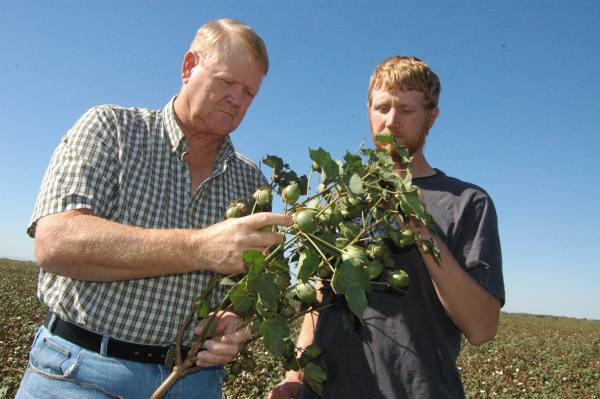September 25, 2012

Cotton is not as tall as it once was in Oklahoma. But it still yields excellent agronomic benefits to wheat and corn rotations by helping hold down weeds, disease and insects. And although cotton prices lag behind grains, there’s still profit in those bolls for Monty Kahle.
“All crops do better when you rotate,” says Kahle, whose northern Oklahoma farm includes a cotton, corn, wheat then back to cotton again rotation. “We’re able to break up disease situations and some insect problems.”
“And as long as we can make money off cotton, even when corn prices are higher, we want to keep it in our rotation,” adds his son, Eric, who joined him on the farm two years ago.
Kahle has been a crusader for cotton in his Newkirk, Okla., region since the early 1990s. That’s when a new gin was built at nearby Blackwell. Unfortunately, increased corn, soybean and wheat prices took too many regional acres out of cotton to sustain the gin.
He now gets his cotton baled in Minco, Okla., just west of Oklahoma City. Kahle also has an interest in Great Plains Cotton Gin, LLC, which owns the Minco gin, as well as a gin near Pratt, Kan.
Equipment upgrades have improved efficiency.
“Since we (started using) a John Deere round bale module building system, transporting the cotton for processing is much easier,” Kahle says.
Fewer acres planted
Oklahoma and Kansas farmers planted fewer cotton acres this year. Oklahoma plantings were at 305,000 acres, down from 415,000 in 2011 according to USDA production statistics. Most of those acres are in Southwestern Oklahoma. Kansas dropped from 80,000 in 2011 to 57,000 this year. The decreases were a result of a price drop from well over $1 pound to about 75 cents, as well as corn and wheat prices that jumped $2 to $3 a bushel.
Wheat will remain king in the Kahles’ region. They had a rotation of one-third each of wheat, corn and cotton in 2011. “For rotation purposes and the early signals of higher cotton prices in 2011, we realigned that rotation to a 10 percent wheat, 45 percent cotton and 45 percent corn in 2012,” Kahle says. “For 2013, we’ll look at a 15 percent to 20 percent cotton, 50 percent wheat and 30 percent corn rotation, with a few acres in sesame.”
The Kahles are primarily no-till and plant into wheat, corn or cotton residue. Cotton varieties are all Roundup Ready stacked with Bollgard II. “We’ve found that even though bollworms are a sub-threshold threat, they still eat for three weeks and can cause some damage,” Kahle says. “The added cost of the Bollgard II is equal to the cost of one spraying (about $7 per acre). We use the Bollgard to take no chances.”
His 2010 and 2011 cotton yielded about 650 pounds of lint for dryland and about 1,000 pounds for irrigated. The 2012 cotton yields are down, due to the drought. “Our dryland will be only about 150 pounds, while our irrigated will be from 700 to 900 pounds,” he says.
But that was certainly better than their corn, which insuranced-out at a pitiful 1 bushel per acre, where it normally yields about 100 bushels for dryland and 150 for irrigated. “The ability of cotton to handle dry, hot weather better than corn is another reason we like it in our rotation,” Kahle says.
On an average year, when rainfall surpasses 35 inches, cotton priced at 75 cents a pound still produces a gross return of about $600 to $700 per acre for the Kahles’ irrigated cotton yielding 800 to 1,000 pounds. It tops about $400 to $500 per acre on dryland yielding 500 to 600 pounds.
That may not equal gross return from $7.50 per bushel corn for a 150-bushel corn. But it’s still a return that can yield a profit, Kahle says.
Double crop wheat after cotton
The Kahles have seen good results in hard red winter wheat planted extremely late. “For three years, we have planted wheat just after Thanksgiving in acres where cotton was just harvested,” Kahle says. “With help from good rains in the early spring this year, our wheat yielded from 48 to 54 bushels. It averaged about 5 to 10 bushels above our wheat-after-wheat yield.”
He credits cotton with improvements in soil nutrients, cleaning out weeds and breaking up disease and insect population cycles and helping boost wheat yields. “Rotation is important for a crop production program,” Kahle says. “And we know that prices will vary for all crops from year to year.
“If the Midwest sees a normal year for rainfall in 2013, corn prices will probably be down because planted acres are expected to be up. That should benefit cotton prices, because acres will probably be down again. So we see a good future in cotton in our northern region.”
About the Author(s)
You May Also Like




